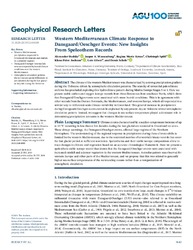Western Mediterranean Climate Response to Dansgaard/Oeschger Events: New Insights From Speleothem Records
Wassenburg, Jasper A.
Gibert, Luis
DOI: https://doi.org/10.1029/2019GL084009
Persistent URL: http://resolver.sub.uni-goettingen.de/purl?gldocs-11858/9147
Persistent URL: http://resolver.sub.uni-goettingen.de/purl?gldocs-11858/9147
Budsky, Alexander; Wassenburg, Jasper A.; Mertz-Kraus, Regina; Spötl, Christoph; Jochum, Klaus Peter; Gibert, Luis; Scholz, Denis, 2019: Western Mediterranean Climate Response to Dansgaard/Oeschger Events: New Insights From Speleothem Records. In: Geophysical Research Letters, Band 46, 15: 9042 - 9053, DOI: 10.1029/2019GL084009.
 |
Dokument öffnen: |
The climate of the western Mediterranean was characterized by a strong precipitation gradient during the Holocene driven by atmospheric circulation patterns. The scarcity of terrestrial paleoclimate archives has precluded exploring this hydroclimate pattern during Marine Isotope Stages 5 to 3. Here we present stable carbon and oxygen isotope records from three flowstones from southeast Iberia, which show that Dansgaard/Oeschger events were associated with more humid conditions. This is in agreement with other records from the Iberian Peninsula, the Mediterranean, and western Europe, which all responded in a similar way to millennial-scale climate variability in Greenland. This general increase in precipitation during Dansgaard/Oeschger events cannot be explained by any present-day or Holocene winter atmospheric circulation pattern. Instead, we suggest that changes in sea surface temperature played a dominant role in determining precipitation amounts in the western Mediterranean.
Statistik:
ZugriffsstatistikSammlung:
Schlagworte:
Spainlast glacial
Dansgaard/Oeschger
speleothem
Marine Isotope Stage 3
western Mediterranean climate
This is an open access article under the terms of the Creative Commons Attribution License, which permits use, distribution and reproduction in any medium, provided the original work is properly cited.

